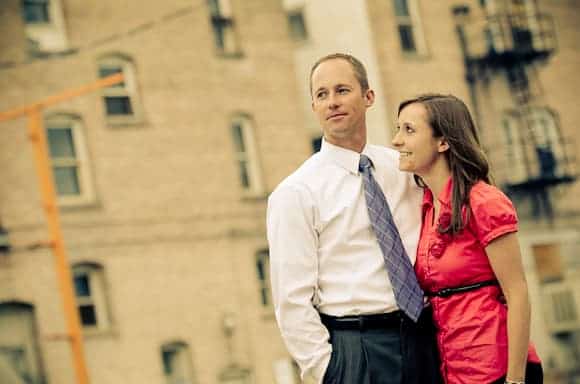If you spend the time to analyze your photography and see what makes one picture stand out from the others as you rate them in Lightroom, you can improve your photography more quickly than doing pretty much anything else.
The idea behind this post is that we sit down together and learn how to analyze a photo. The photo is from a shoot I did earlier this week for an engaged couple who live in a tiny rural town.
I met with the couple to talk about the details of the shoot and choose a location. I looked on their refrigerator and saw a few wedding announcements from their friends. Yup, you guessed it. Hay bales and matching denim, sitting on the edge of an old rusty tractor, and kissing in the barn. All the photos were total small town clichés.
I needed to find somewhere unique to shoot that their friends wouldn’t recognize. So, I asked the couple where they’d like to shoot. As they told me their answers, I crossed off each of their locations in my mind. I knew I didn’t want to go anywhere typical. So, I looked around the town and found a killer old building. Perfect! No matching denim and hay bales. That’s all I asked for.
Here’s the photo that we ended up with…
It’s a fun engagement shot. It’s certainly not the kind of photo that makes people weak in the knees and faint from excessive exposure to awesomeness. But, it turned out nice. Like I said, this post is about analyzing the photos we take, and this is what I took this week. So what 5 lessons can we learn from this portrait? Let’s go…
Lesson #1: Use a long lens to give the impression that the background is closer than it really is. I know, I know, the lens isn’t really compressing the distance. I get the technical part of it, but there is no way that anyone can deny that using a long lens makes it seem like the background is closer than it really is. For this photo, I used a 200mm lens. The building in the background was actually about 150 yards (137 meters) away, but the long lens makes it feel like the building is only 30 feet (9.1 meters) away. By using this technique the background becomes part of the photo.
Lesson #2: It really is time to get away from people staring down the lens. I know I’ve harped on this point several times in the last couple weeks, but I keep seeing portraits that would look so much nicer if the models weren’t looking at the camera. I’m not saying never, I’m just saying that a little variety is nice.
Lesson #3: Depth-of-field is more than just aperture. If I would have shot this photo at 200mm with a long distance between the couple and the building and an aperture under f/5.6 (as would be typical for a portrait), then the building would have just been a blur. Sometimes portrait photographers get so fanatical about low apertures that they use shallow depth-of-field where deeper depth-0f-field is needed. In this photo, I wanted a little blur on the background to make the couple pop, but I wanted to see what the building looks like. It was the building that made me want to take this shot in the first place.
Lesson #4: Your horizon doesn’t have to be straight. This would have been a much more dull photo if the horizon were perfect. I wanted a slightly tilted horizon to bring some interest into the composition.
Lesson #5: If it ain’t broke… don’t fix it. It’s a fact of nature: When a photographer discovers off-camera flash, he will shoot every portrait with flash for the next 3 years. The ambient light for this photo was perfectly fine. There was nothing to fix and dramatic lighting probably would have distracted more than it would add.



